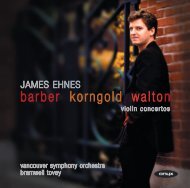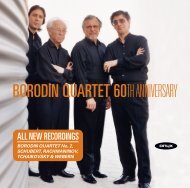BRAHMS Piano Quartets 1 & 3 - Onyx Classics
BRAHMS Piano Quartets 1 & 3 - Onyx Classics
BRAHMS Piano Quartets 1 & 3 - Onyx Classics
Sie wollen auch ein ePaper? Erhöhen Sie die Reichweite Ihrer Titel.
YUMPU macht aus Druck-PDFs automatisch weboptimierte ePaper, die Google liebt.
<strong>BRAHMS</strong><br />
<strong>Piano</strong> <strong>Quartets</strong> 1 & 3<br />
THE NASH ENSEMBLE
Johannes Brahms
JOHANNES <strong>BRAHMS</strong> (1833–1897)<br />
<strong>Piano</strong> Quartet no. 1 in G minor, op. 25<br />
g-moll · sol mineur<br />
1 I Allegro 14.12<br />
2 II Intermezzo: Allegro ma non troppo 7.59<br />
3 III Andante con moto 9.50<br />
4 IV Rondo alla Zingarese: Presto 8.18<br />
<strong>Piano</strong> Quartet no. 3 in C minor, op. 60<br />
c-moll · ut mineur<br />
5 I Allegro ma non troppo 10.23<br />
6 II Scherzo: Allegro 4.23<br />
7 III Andante 8.38<br />
8 IV Finale: Allegro 10.12<br />
Total timing: 74.03<br />
The Nash Ensemble<br />
Artistic Director: Amelia Freedman CBE, FRAM<br />
Ian Brown piano<br />
Marianne Thorsen violin<br />
Lawrence Power viola<br />
Paul Watkins cello
Brahms: <strong>Piano</strong> <strong>Quartets</strong><br />
In July 1861 Brahms moved to Hamm, a picturesque country suburb on the left bank of the Alster<br />
near Hamburg. There, the idyllic home of Elisabeth Rösing provided him with an inspiring environment<br />
in which to compose. The resultant outpouring began with his first two complete <strong>Piano</strong><br />
<strong>Quartets</strong>, in G minor and A major. The first, op. 25, had already been conceived some years before,<br />
around 1857. But it was at Hamm that it finally came to fruition, combining a wide-ranging musical<br />
language with a symphonic breath of formal vision – as Arnold Schoenberg observed by making a<br />
spectacular orchestral transcription.<br />
On completion the G minor Quartet was, as with so much of Brahms’ output, sent to Clara Schumann<br />
for comment. Clara and another of Brahms’ close friends, the violinist Joseph Joachim, criticised the<br />
opening movement for its brooding character, fluidity of form and preoccupation with the secondary<br />
key area of D major. However, Brahms would, in time, be hailed as innovative for his employment<br />
of these devices.<br />
Brahms’ manuscript for the opening movement includes a repeat sign at the end of the exposition,<br />
but this was scribbled out and replaced by ten bars reiterating the opening material – a false reprise<br />
– before a pause heralds the start of the development. In similar vein, the recapitulation begins<br />
ambiguously in G major rather than the expected tonic, rendering its starting point unclear; Clara<br />
took a dim view of what she saw as uncertainty, but for Brahms such formal flexibility was the best<br />
means of expressing his ideas.<br />
The turbulence of the opening movement is thrown into relief by the C minor Intermezzo that follows.<br />
This is an early instance of the kind of subtle scherzo, less frenetic than those of Beethoven,<br />
which became a hallmark of Brahms’ oeuvre; its understated vocabulary offers a piquant counterpoint<br />
to the unbuttoned emotions of the outer movements. Brahms did initially label the movement<br />
‘Scherzo’, but changed it to ‘Intermezzo’ at Clara’s suggestion. The main theme makes use of Robert<br />
Schumann’s ‘Clara’ theme (C–B–A–G sharp–A, the B standing for l and G sharp for r).<br />
Yet in the Andante con moto it is as though the burden carried by the first two movements has lifted;<br />
a full-throated, lyrical theme in E flat is offset by a jaunty march in C major. This relaxation in<br />
turn presages an infectiously exuberant finale alla Zingarese, an updating of the genre of ‘gypsy’<br />
finale pioneered by Haydn. The virtuosity demanded of the performers, in particular from the
pianist, shows an extrovert side to the composer’s musical personality, one that only surfaced intermittently.<br />
Joachim, who shared his love of Hungarian folk music, was suitably impressed, observing<br />
wryly that: ‘In the last movement you beat me on my own turf’.<br />
Brahms moved to Vienna in September 1862, where he met Conservatoire professor Julius Epstein,<br />
who lived in an historic house in Schulerstrasse: the very same building in which Mozart had composed<br />
Le nozze di Figaro, Haydn had praised Mozart to his father Leopold, and where Mozart had predicted<br />
a great future for the teenage Beethoven. Following in this hallowed tradition, it was after a<br />
rehearsal for the G minor Quartet there that the violinist Josef Hellmesberger reportedly embraced<br />
Brahms and exclaimed: ‘This is the heir of Beethoven!’ The first performance in Vienna followed in<br />
November with the composer at the piano. The rumbustious energy of the Rondo alla Zingarese<br />
prompted a rapturous standing ovation, and the start of a collection of ‘Brahmsians’ in Vienna.<br />
In 1868 Brahms had spent several weeks working in Bonn, much of it in the company of the critic<br />
Hermann Deiters, who in 1880 would write a biography of Brahms. It was to Deiters that Brahms<br />
showed some of the <strong>Piano</strong> Quartet in C minor, with the words: ‘Imagine a man who is just about to<br />
shoot himself, and to whom no other course is left.’ This was by way of explaining to Deiters music<br />
that had begun life some 15 years before (originally in the key of C sharp minor), when Brahms’<br />
obsession with Clara was at fever pitch, infecting his music so powerfully that even recalling that<br />
frame of mind brought the impassioned feelings – and their musical equivalent – flooding back.<br />
The suicidal image was one that Brahms reiterated several times. To his publisher Simrock, Brahms<br />
wrote of the quartet:<br />
‘On the cover you must have a picture, namely a head with a pistol to it. Now you can form some conception<br />
of the music! I’ll send you my photograph for the purpose. Since you seem to like colour printing, you can use<br />
blue coat, yellow breeches and top boots.’<br />
These details would have been instantly recognisable to any of Brahms’ contemporaries: the coat,<br />
breeches and boots refer to Goethe’s Young Werther, who wore these garments as he killed himself<br />
over the love of a woman whose husband he admired. Brahms could hardly be more explicit: the C<br />
minor <strong>Piano</strong> Quartet enshrined his forbidden love for Clara Schumann, as it does the Clara motif<br />
(here disguised in another key).
Brahms’ revisions included lowering its key from C sharp minor to C minor, rewriting the original<br />
finale to become the scherzo and composing both the glorious Andante and a new finale. The work<br />
was finally completed in 1874 and premiered in the Musikverein in November 1875, with Brahms at<br />
the piano and Hellmesberger playing the violin. The audience included Richard and Cosima Wagner,<br />
attending in a (as it turned out, temporary) gesture of reconciliation.<br />
For all its subtext, Clara Schumann was again critical of the C minor Quartet’s opening movement. The<br />
opening few bars of the first movement feature a string sonority almost as plangent as a Purcell viol<br />
Fantazia; this stark quality, contrasting with the unfettered Romanticism heard elsewhere, also offers<br />
moments of reflection amid the overwhelming passion of the scherzo. There is respite, too, in the first<br />
movement’s autumnal second subject area, and in the poignant second theme of the scherzo. But<br />
there is no trio to balance the scherzo’s intensity, betraying its original conception as a finale.<br />
The gorgeous Andante brings sensual interplay between the strings, creating a quintessentially<br />
Brahmsian mood of mingled wistfulness and warmth. The finale opens with a long violin solo over<br />
inexorable moto perpetuo quavers, followed by a string chorale with sardonic interjections from the<br />
piano. After a shadowy development, the chorale theme is ferociously reiterated on the piano,<br />
before the terse final chords bring extinction. There is no peaceful resolution – let alone the gypsystyle<br />
celebration of the earlier G minor quartet – but a triumph of desolation, as befits the suicidal<br />
subject matter alluded to by Brahms. Here at least, Friedrich Nietzsche may have had a point when<br />
he described Brahms as ‘the musician of the unsatisfied’.<br />
Joanna Wyld, 2008
Brahms: Klavierquartette<br />
Im Juli 1861 zog Brahms nach Hamm, einen ländlichen Hamburger Vorort am linken Alsterufer. Dort<br />
bot ihm das idyllisch gelegene Haus von Elisabeth Rösing eine Umgebung, die ihn zum Komponieren<br />
inspirierte. Das erste Ergebnis dieser sehr schöpferischen Phase waren die beiden Klavierquartette in<br />
g-moll und A-dur. Das erste Quartett, op. 25, hatte der Komponist bereits vor einigen Jahren, um<br />
1857, skizziert, aber erst in Hamm gab er ihm konkrete Gestalt. Er verlieh der ausgreifenden<br />
musikalischen Sprache einen sinfonischen Atem, der die Vision einer neuen Form in sich barg, so dass<br />
Arnold Schönberg, der eine hervorragende Transkription für Orchester anfertigte, das Werk<br />
„Brahms’ Fünfte“ nannte.<br />
Nachdem Brahms das Quartett in g-moll vollendet hatte, schickte er es, wie er es mit vielen seiner<br />
Werke zu tun pflegte, zur Begutachtung an Clara Schumann. Diese und ein anderer enger Freund des<br />
Komponisten, der Geiger Joseph Joachim, kritisierten im Kopfsatz den grüblerischen Charakter, die<br />
fließende Form und die betonte Verwendung der Nebentonart D-dur – Stilmittel, die jedoch später<br />
als Neuerungen bejubelt werden würden.<br />
Brahms’ Autograph des Kopfsatzes enthielt am Ende der Exposition ein Wiederholungszeichen, das<br />
jedoch durchgestrichen und durch zehn Takte ersetzt worden war, die – als falsche Reprise – das<br />
Anfangsmaterial wiederholen, bevor eine Pause den Beginn der Durchführung ankündigt. Auf ähnliche,<br />
doppeldeutige Weise beginnt die Reprise in G-dur statt in der erwarteten Tonika und macht<br />
somit den Ausgangspunkt missverständlich. Clara missbilligte das, weil sie es für Unsicherheit hielt,<br />
für Brahms jedoch war ein derart flexibler Umgang mit der Form das beste Mittel, seine Ideen zum<br />
Ausdruck zu bringen.<br />
Einen krassen Gegensatz zu dem turbulenten Geschehen im Kopfsatz bietet das sich anschließende<br />
Intermezzo in c-moll. Es ist ein frühes Beispiel für jene Art feinsinniger Scherzi, die – weniger<br />
frenetisch als bei Beethoven – zu Brahms’ Markenzeichen wurden; das absichtlich zurückhaltend<br />
eingesetzte Vokabular liefert einen pikanten Kontrapunkt zu den zwanglos geäußerten Emotionen<br />
der Ecksätze. Brahms hatte den Satz ursprünglich „Scherzo“ genannt, folgte aber dann Claras Rat und<br />
gab ihm den Titel „Intermezzo“. Das Hauptthema verwendet Robert Schumanns „Clara“-Thema<br />
(C–H–A–Gis–A, das H steht für l und Gis für r).
Das Andante con moto erweckt jedoch den Anschein, als wäre die schwere Last, die von den ersten beiden<br />
Sätzen getragen wurde, nicht mehr vorhanden; ein volltönendes, lyrisches Thema in Es ist gegen<br />
einen flotten Marsch in C-dur gesetzt. Diese Entspannung wiederum kündigt ein in seinem Überschwang<br />
unwiderstehliches Finale alla Zingarese an, eine Neuauflage des Finales „im Zigeunerstil“, dem<br />
Haydn den Weg bereitet hatte. Die Virtuosität, die dieses Stück von den ausführenden Musikern verlangt,<br />
vor allem dem Pianisten, zeigt eine extrovertierte Seite der musikalischen Persönlichkeit des<br />
Komponisten, wie sie nur gelegentlich zum Vorschein kam. Joachim, der seine Liebe zur ungarischen<br />
Volksmusik teilte, bemerkte trocken, Brahms schlage ihn im letzten Satz auf seinem eigenen Gelände.<br />
Im September 1862 zog Brahms nach Wien, wo er Julius Epstein kennenlernte, der in der<br />
Schulerstraße in einem Haus von historischer Bedeutung wohnte, in genau dem Gebäude, in dem<br />
Mozart seine Oper Le nozze di Figaro komponiert, Haydn gegenüber Vater Leopold Mozarts<br />
musikalisches Genie gerühmt und Mozart wiederum dem jungen Beethoven eine große Zukunft<br />
vorhergesagt hatte. Als Fortsetzung dieser heiligen Tradition soll bei einer Probe des Quartetts in<br />
g-moll der Geiger Josef Hellmesberger Brahms umarmt und ausgerufen haben: „Das ist der Erbe<br />
Beethovens!“. Die Uraufführung folgte im November in Wien mit dem Komponisten am Klavier. Die<br />
unbändige Energie des Rondo alla Zingarese erhielt so stürmischen Beifall, dass sich in Wien eine<br />
Gruppe begeisterter Brahmsianer formierte.<br />
1868 verbrachte Brahms einige Wochen in Bonn, häufig in Begleitung des Kritikers Hermann Deiters,<br />
der 1880 eine Brahms-Biographie schreiben würde. Deiters war es, den Brahms Auszüge aus seinem<br />
Klavierquartett in c-moll mit den Worten begutachten ließ: „Nun stellen Sie sich einen Menschen<br />
vor, der sich eben totschießen will und dem nichts anderes übrig bleibt“. Damit erläuterte er Deiters<br />
eine Musik, deren Anfänge rund 15 Jahre zurücklagen (ursprünglich in der Tonart cis-moll), als seine<br />
Leidenschaft zu Clara aufgeflammt war und seine Musik so gewaltig beeinflusst hatte, dass allein die<br />
Erinnerung an diesen Seelenzustand diese heftigen Gefühle – und ihre musikalische Entsprechung –<br />
zurückfluten ließ.<br />
Dieses Bild eines Menschen, der mit dem Gedanken spielt, Selbstmord zu begehen, verwendete<br />
Brahms noch mehrere Male. An seinen Verleger Simrock schrieb er zu dem Quartett:<br />
„Sie dürfen auf dem Titelblatt ein Bild anbringen, nämlich einen Kopf mit der Pistole davor. Nun können Sie sich<br />
einen Begriff von der Musik machen! Ich werde Ihnen zu dem Zweck meine Photographie schicken! Blauen<br />
Frack, gelbe Hose und Stulpstiefeln können Sie auch anwenden…“
Diese Anspielungen waren für Brahms’ Zeitgenossen auf Anhieb verständlich: Frack, Hose und Stiefel<br />
bezogen sich auf Goethes jungen Werther, der diese Kleidungsstücke trug, als er sich aus Liebe zu<br />
einer Frau tötete, deren Mann er bewunderte. Deutlicher konnte Brahms kaum werden: Das<br />
Klavierquartett in c-moll birgt seine verbotene Liebe zu Clara Schumann – ebenso wie das<br />
Clara-Motiv (hier durch eine andere Tonart getarnt).<br />
Bei der Überarbeitung des Werkes setzte Brahms cis-moll in die tiefere Tonart c-moll, schrieb das<br />
ursprüngliche Finale zu einem Scherzo um und komponierte das wunderbare Andante sowie ein<br />
neues Finale. Als das Quartett schließlich 1874 vollendet war, fand im November 1875 im Wiener<br />
Musikverein die Uraufführung statt – mit Brahms am Klavier und Hellmesberger, der die Violine<br />
spielte. Zum Publikum gehörten Richard und Cosima Wagner – die Geste einer (wie sich erweisen<br />
sollte, nicht lange währenden) Versöhnung.<br />
Angesichts der unterschwelligen Bedeutung des c-moll-Quartetts erhob Clara Schumann immer<br />
noch Einwände gegen den Kopfsatz. Die einleitenden Takte des ersten Satzes weisen einen fast ebenso<br />
klagenden Streicherklang auf wie Purcells Fantazia für Viola; diese beklemmende Öde, die mit der<br />
sich anderswo ungehindert äußernden Romantik kontrastiert, bietet auch inmitten der überwältigenden<br />
Leidenschaft des Scherzos Momente der Reflexion. Ein wenig Erholung bringt im ersten Satz<br />
auch die herbstliche Stimmung, die das zweite Thema umhüllt, sowie das schmerzerfüllte zweite<br />
Thema des Scherzos. Aber es gibt kein Gegengewicht zum Ausgleich des heftigen Scherzos, das damit<br />
seinen Ursprung als Finalsatz verrät.<br />
Das wunderbare Andante bietet ein sinnliches Wechselspiel zwischen den Streichern und schafft<br />
eine für Brahms typische Stimmung der Wärme, die von Wehmut durchtränkt ist. Das Finale beginnt<br />
mit einem langen Violinsolo über einem unerbittlichen Moto perpetuo aus Achtelnoten, auf das<br />
ein Streicherchoral mit sardonischen Einwürfen seitens des Klaviers folgt. Nach einer verhangenen<br />
Durchführung führt das Klavier das Choralthema wütend weiter, bis es die knappen Schlussakkorde<br />
verlöschen lassen. Es gibt keine friedliche Lösung – erst recht keine Feier auf Zigeunerart wie im<br />
früheren Quartetts in g-moll, hier triumphiert die Einsamkeit, dem Thema Selbstmord angemessen,<br />
auf das Brahms anspielte. Hier wenigstens mag Friedrich Nietzsche recht gehabt haben, als er sagte,<br />
Brahms mache „Musik für die Unbefriedigten aller Art“.<br />
Joanna Wyld<br />
Übersetzung: Gudrun Meier
The Nash Ensemble<br />
‘These Nash musicians live gold. They play gold.’ The Times<br />
The Nash Ensemble has built up a remarkable reputation as one of Britain’s finest chamber groups,<br />
and through the dedication of its founder and artistic director Amelia Freedman and the calibre of<br />
its players, has gained a similar reputation all over the world. The repertoire is vast and the<br />
imaginative, innovative and unusual programmes are as finely architectured as the beautiful Nash<br />
terraces in London from which the group takes its name. Not that the Nash Ensemble is classically<br />
restricted; it performs with equal sensitivity and musicality works from Mozart to the avant-garde,<br />
having given first performances of, to date, over 255 new works, including 144 commissions of<br />
pieces especially written for it, providing a legacy for generations to come. An impressive<br />
collection of recordings illustrates the same varied and colourful combination of classical<br />
masterpieces, little-known neglected gems and important contemporary works. The Nash makes<br />
many foreign tours: concerts have been given throughout Europe and the USA, and in South<br />
America, Australia and Japan. The group is a regular visitor to many British music festivals and can<br />
be heard on radio, television, at the South Bank and the BBC Proms, at music clubs throughout the<br />
country and at Wigmore Hall. The ensemble has won the Edinburgh Festival Critics’ music award<br />
‘for general artistic excellence’, and two Royal Philharmonic Society awards in the small ensemble<br />
category ‘for the breadth of its taste and its immaculate performance of a wide range of music’.
Also available from the Nash Ensemble on ONYX<br />
ONYX 4011 ONYX 4019<br />
Mendelssohn: <strong>Piano</strong> Trios<br />
Brahms: String Sextets<br />
BBC CD Review ‘CD of the week’<br />
Gramophone 'Editor's Choice'<br />
Executive producer for ONYX: Paul Moseley<br />
Producer: Andrew Keener<br />
Balance Engineer: Phil Rowlands<br />
Recording location: The Menuhin Hall, Stoke d’Abernon, England 10–12 January 2007<br />
Cover photo: Mark Millington<br />
Design: Mark Millington for WLP Ltd<br />
www.onyxclassics.com
www.onyxclassics.com<br />
ONYX 4029















